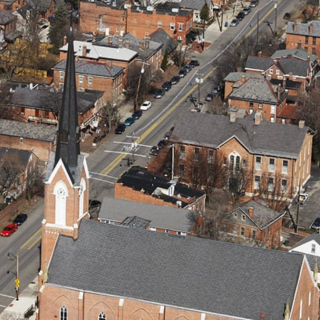“Eighty percent of everything ever built in America has been built in the last 50 years, and most of it is depressing, brutal, ugly, unhealthy, and spiritually degrading” – James Howard Kunstler, from his book The Geography of Nowhere
In the City of Pickerington the final resting place of a veteran who fought to end slavery has become surrounded by overwhelming traffic and besieged by over-priced coffee. A handful of living veterans grumbled, angered to see a Starbucks seemingly built over night was now practically on top of the Civil War veteran’s small cemetery. But once again the concerns of loyal and proud citizens were too late as developers and retailers had struck again.
It didn’t matter that the cemetery, Pisgah Cemetery on State Route 256, is one of the oldest in Ohio. What obviously mattered more was the traffic. According to Pickerington city officials, over 30,000 cars per day head south on State Route 256 during morning rush hour. Most access an I-70 on-ramp and head west to downtown Columbus. The cemetery is just a short walk from the on-ramp, but it’s not recommended because there are no sidewalks.
This stretch of 256 is arguably the most congested road in Central Ohio (see related video from the QR code above or at ColumbusFreePress.com). Aside from the sheer number of cars, truly surprising is the fact this intersection is nearly 25 miles outside the urban center of Columbus. What’s more, it’s not even in Franklin County – it’s in Fairfield County.
But while the traffic on 256 has locals losing their minds when they go to work (and when they come home), corporate retailers are drooling. Nearly every major retailer and chain restaurant has staked a claim on 256 knowing their brand is exposed to thousands of consumers who move (slowly) with the heavy traffic.
This past summer developers were so desperate to squeeze more businesses into what little space is left on 256, they built a plaza that nearly encircles Pisgah Cemetery. The outdoor patio of the Starbucks is mere feet from headstones, for instance.
The public apparently had little say if any in the decision. Pickerington, one of the fastest growing communities in Ohio, has “Growth Management Meetings” once a week on Tuesday afternoon, and you have to call ahead of time for any city official to show.
“This 92-year-old veteran of World War II saw what had been done near the cemetery, and he called me, and his language was very colorful,” says Ted Hackworth, the only member of the Pickerington zoning commission to vote ‘no’ against the Pisgah Cemetery shopping plaza. “He said, ‘What the hell are they doing to that cemetery!’ That was the calm part of it.”
The city hastily erected a white plastic fence around the cemetery. “I don’t know what they’re [Starbucks and others] thinking,” says Hackworth, eluding to the fact there’s plenty of space several miles west (closer to downtown), on Brice Road and Hamilton Road where several big box retail stores and other shopping plazas remain deserted.
Indeed, the 40-acre Consumer Square East shopping center on Brice Road was mostly torn down in 2008 leaving behind a massive overgrown parking lot that borders I-70 East and I-70 West. Which means the number of eyes on this eye-sore is astronomical.
William Dodson, a well-respected northeast Columbus community activist and small business advocate, has been seeking developers to build coffee shops and sit-down restaurants in his community for over two decades. But for the most part developers have given him and his community a cold shoulder, even though 9,000 new homes and apartments were constructed over the last 10 years.
The heart of Dodson’s community is the intersection of Agler Road and Cassady Avenue. Where “there’s no retail core other than carry-outs,” he says. Not far from here is over 20 acres of undeveloped land.
He says the perception that developers and retailers have government office holders and regional planners under their spell is no myth.
“The developers have the clout and city planners work to facilitate their clout,” he says, “they [elected officials] simply follow the lead of developers. It’s not that there’s no place to develop, there’s not the will to develop.”
Rarely, some push back against the power of developers and corporate retailers. Recently, four Dublin city zoning commissioners – who are residents and not elected officials – made a bold and noteworthy statement against the Dublin City Council. They resigned in protest this December claiming city council has amended zoning laws so to significantly limit public input on development issues.
Dodson says the outgoing Dublin zoning commissioners should be commended for making a stand, but this group is far and few between.
As for State Route 256 the cost of urban sprawl is steep. The City of Pickerington is gearing up for what they are calling a “Safety Project” by adding a third southbound lane to a stretch of 256 considered a bottleneck. Nearly 80 percent of the $7 million project is coming from the Ohio Department of Transportation.
To make room for the new southbound lane, over two-hundred flowering pear trees on 256 will be destroyed. As the community paper the Pickerington Time-Suns recently reported, the tree removal is to establish a “boulevard feel” so to allow businesses on 256 “crucial exposure” to passing motorists.



